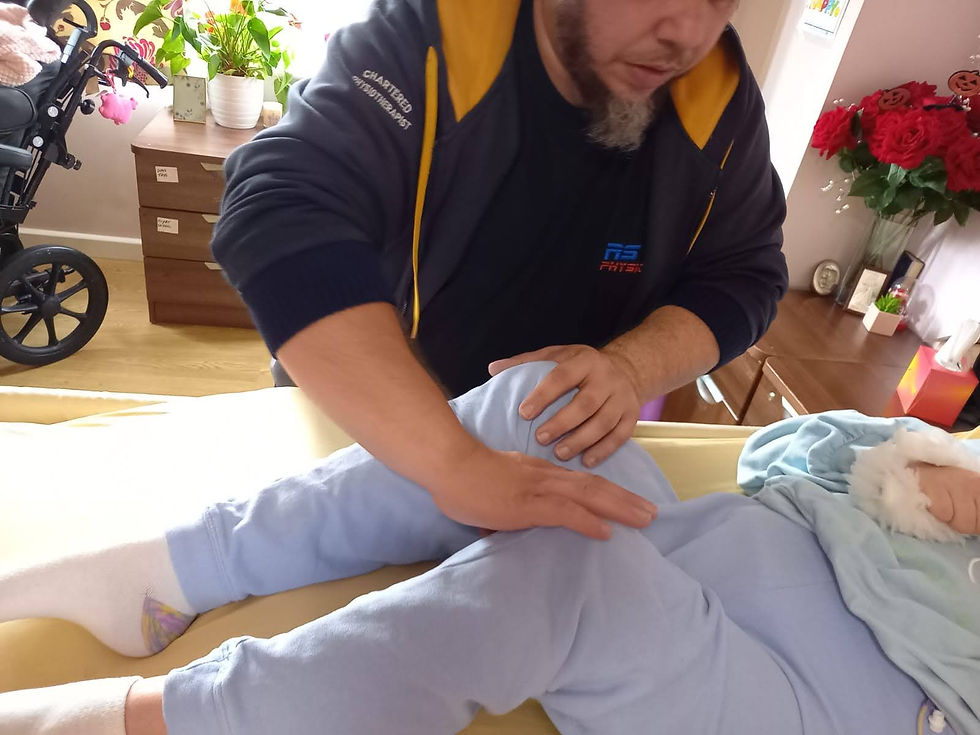How would You Connect Christmas Decorations with Asthma Physiotherapy Update?
- Pawel Ciecierski MSc Physiotherapy MCSP HCPCreg

- Dec 20, 2023
- 4 min read

Ho Ho.
Christmas is approaching fast, in my little world too. This Christmas, unexpectly just like unwelcomed unexpected hospital stay, I'll provide an update on asthma.
As a neurophysiotherapist with mandatory respiratory experience for my profession, I have always been fascinated by the interplay between breathing, physical health, and the management of respiratory conditions associated with neurological disorders.
However, I had typically focused less on standalone respiratory conditions. This perspective shifted dramatically after a little unexpected dusted decorations incident. My daughter was hospitalized due to an asthma exacerbation, triggered by a seasonal viral infection and exacerbated by dust from last year’s Christmas decorations. This event led me to explore the latest advancements in asthma management.
I start my research of articles and I came across the study titled ‘Physiotherapy Breathing Retraining for Asthma: A Randomised Controlled Trial,’ published in 2018 in ‘The Lancet Respiratory Medicine.’
Out of 15,203 patients invited, 655 participated. They were randomly assigned to either the DVD and booklet intervention (DVDB), face-to-face sessions, or standard care.
Both the DVDB and face-to-face interventions significantly improved the quality of life compared to usual care, with similar improvements noted in both intervention groups. Importantly, there were no significant differences in lung function or airway inflammation among the groups. Similar rates of adverse events were reported across all groups as well.
The digital program (DVDB) was found to be more convenient and cost-effective, potentially reducing healthcare costs. The study suggests that breathing retraining programs can be effectively delivered digitally, improving the quality of life for asthma patients with minimal impact on lung function or inflammation. This approach offers a non-pharmacological treatment option and can be integrated into standard care.
The intervention involved a DVD and a printed booklet, which contained an evidence-based, self-guided intervention designed by a multidisciplinary team, including physiotherapists.
It featured detailed explanations and illustrations of breathing exercises, such as diaphragmatic breathing, nasal breathing, slow breathing, controlled breath holds, and simple relaxation exercises.
This holistic approach is crucial for asthma patients, offering them tools to improve their quality of life through better self-management.
Moreover, the study included face-to-face sessions with a respiratory physiotherapist, providing breathing retraining over three one-to-one sessions, each lasting about 40 minutes, and spaced approximately every two weeks. These sessions followed a standardized intervention schedule, ensuring consistency and adherence to the protocol.
As a physiotherapist, these findings are particularly exciting as they demonstrate again the effectiveness of physiotherapy-based breathing training, not only in a face-to-face setting but also through digital media and in the community I working for.
This opens up new avenues for patient education and self-management, crucial aspects of long-term asthma care. The study’s innovative approach to delivering these interventions digitally means that more patients can access these vital tools, despite the scarcity of specialized physiotherapists.
Fast forward to 2023, and the Global Initiative for Asthma (GINA) has released a comprehensive report that further illuminates the dynamic nature of asthma treatment, including the potential role of physiotherapy within it. As a professional, this report is invaluable.
As we venture further into the realm of physiotherapy and respiratory care, let’s remember the human element in all of this. Our work is not just about improving clinical outcomes but also about touching lives, offering comfort, and providing hope for effective health care.
If you need bite more there is some references
1. Bruton, A., Lee, A., Yardley, L., et al. (2018). Physiotherapy breathing retraining for asthma: a randomised controlled trial. The Lancet Respiratory Medicine, 6(1), 19-28. Link to Study
2. Global Initiative for Asthma (GINA). (2017). Global strategy for asthma management and prevention.
3. Juniper, E. F., Guyatt, G. H., Epstein, R. S., et al. (1992). Evaluation of impairment of health-related quality of life in asthma: development of a questionnaire for use in clinical trials. Thorax, 47(1), 76-83.
4. Yardley, L., Morrison, L., Bradbury, K., & Muller, I. (2015). The person-based approach to intervention development: application to digital health-related behavior change interventions. Journal of Medical Internet Research, 17(1), e30.
5. Arden-Close, E., Teasdale, E., Tonkin-Crine, S., et al. (2013). Patients’ perceptions of the potential of breathing training for asthma: a qualitative study. Primary Care Respiratory Journal, 22(4), 449-53.
6. Thomas, M., Bruton, A., Little, P., et al. (2017). A randomised controlled study of the effectiveness of breathing retraining exercises taught by a physiotherapist either by instructional DVD or in face-to-face sessions in the management of asthma in adults. Health Technology Assessment, 21(1), 1-162.
7. Juniper, E. F., O’Byrne, P. M., Guyatt, G. H., et al. (1999). Development and validation of a questionnaire to measure asthma control. European Respiratory Journal, 14(4), 902-07.
8. Van Dixhoorn, J., & Duivenvoorden, H. J. (1985). Efficacy of the Nijmegen questionnaire in recognition of the hyperventilation syndrome. Journal of Psychosomatic Research, 29(2), 199-206.
9. Zigmond, A. S., & Snaith, R. P. (1983). The hospital anxiety and depression scale. Acta Psychiatrica Scandinavica, 67(6), 361-70.
10. Bateman, E. D., Esser, D., Chirila, C., et al. (2015). Magnitude of effect of asthma treatments on asthma quality of life questionnaire and asthma control questionnaire scores: systematic review and network meta-analysis. Journal of Allergy and Clinical Immunology, 136(4), 914-22.





Comentários